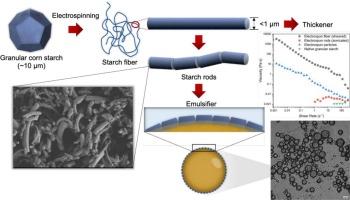利用气体辅助电纺丝技术从淀粉中提取棒状颗粒设计增稠剂和皮克林乳化剂
IF 10.7
1区 化学
Q1 CHEMISTRY, APPLIED
引用次数: 0
摘要
淀粉的大粒径和紧密的半晶体结构限制了其作为乳化剂和剪切可逆增稠剂的功效。为了解决这个问题,我们使用气体辅助电纺丝技术将大颗粒淀粉转化成细纤维,然后再转化成棒状颗粒,用作淀粉基增稠剂和乳化剂。通过调节甲酸中的淀粉浓度和电纺丝参数,喷射出的聚合物形成了不同的形状。在淀粉含量较低(5 w/w%)时,电喷雾产生的颗粒较小(直径为 0.4-3.0 μm)。浓度较高时,聚合物会缠结在一起,有利于纤维的形成(直径为 0.5-3.9 μm)。通过调节流速、同轴气流压力、电压、针规和喷射距离,可对淀粉的形态行为进行微调。长时间的甲酸处理(4 天)会导致纤维向珠子的转变。纤维悬浮液的粘度(剪切速率为 0.002 s-1 时为 3215 Pa-s)比未改性淀粉高出 ∼106 倍。纺丝后使用高剪切和超声波将纤维切成棒状颗粒(长度分别为 4、6 和 8 μm),作为有效的乳化剂。最长的棒状颗粒(8 μm)能稳定乳状液中最小的液滴(12 μm)。这项研究利用食品安全聚合物证明,颗粒的形状在调节材料功能方面发挥着重要作用。本文章由计算机程序翻译,如有差异,请以英文原文为准。

Using gas-assisted electrospinning to design rod-shaped particles from starch for thickening agents and Pickering emulsifiers
Starch's large particle size and compact semi-crystalline structure limit its effectiveness as an emulsifier and shear-reversible thickener. To address this, we used gas-assisted electrospinning to convert large starch granules into thin fibers and then into rod-shaped particles for use as starch-based thickeners and emulsifiers. Manipulating the starch concentration in formic acid, and the electrospinning parameters, caused the jetted polymers to form different shapes. At low starch content (<5 w/w%), electrospraying produced smaller particles (0.4–3.0 μm diameter). At higher concentrations, the polymers tangled and favored the formation of fibers (0.5–3.9 μm diameter). The starch's morphological behavior was fine-tuned by adjusting flow rate, coaxial airflow pressure, voltage, needle gauge, and jetting distance. Extensive formic acid treatment (> 4 days) caused a fiber-to-bead transition. Fiber suspensions exhibited ∼106-times higher viscosity (3215 Pa·s at a shear rate of 0.002 s−1) than unmodified starch. High-shear and ultrasonication were used post-spin to chop the fibers into rod-shaped particles (4, 6 and 8 μm length), which were used as effective emulsifiers. The longest rods (8 μm) stabilized emulsions with the smallest droplets (12 μm). Using food-safe polymers, this study demonstrated that the shape of particles plays important roles in modulating the material functionalities.
求助全文
通过发布文献求助,成功后即可免费获取论文全文。
去求助
来源期刊

Carbohydrate Polymers
化学-高分子科学
CiteScore
22.40
自引率
8.00%
发文量
1286
审稿时长
47 days
期刊介绍:
Carbohydrate Polymers stands as a prominent journal in the glycoscience field, dedicated to exploring and harnessing the potential of polysaccharides with applications spanning bioenergy, bioplastics, biomaterials, biorefining, chemistry, drug delivery, food, health, nanotechnology, packaging, paper, pharmaceuticals, medicine, oil recovery, textiles, tissue engineering, wood, and various aspects of glycoscience.
The journal emphasizes the central role of well-characterized carbohydrate polymers, highlighting their significance as the primary focus rather than a peripheral topic. Each paper must prominently feature at least one named carbohydrate polymer, evident in both citation and title, with a commitment to innovative research that advances scientific knowledge.
 求助内容:
求助内容: 应助结果提醒方式:
应助结果提醒方式:


